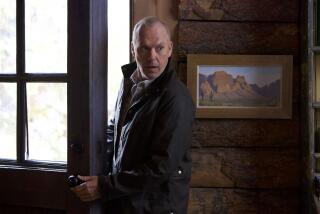‘Man Who Wasn’t There’ Has Presence
- Share via
You could call it an existential film noir comedy. You could describe it as chilly as well as amusing, playful in a dark and ominous way. You could say a lot about the very satisfying “The Man Who Wasn’t There,” but what’s for sure is that no one but the deadpan, dead-on Coen brothers could have turned it out.
Having assured, accomplished fun with a variety of genres has characterized the brothers’ eclectic output since co-writers Joel and Ethan (the former directs, the latter produces) began making features with 1984’s “Blood Simple.” While their last effort, “O Brother, Where Art Thou?,” successfully mixed Greek and movie mythology with American roots music, this one uses Roger Deakins’ crystalline wide-screen black and white photography (a first for the Coens) to smartly reconstruct a claustrophobic world inspired by hard-boiled writer James M. Cain and starring Billy Bob Thornton. Cain, along with Raymond Chandler, Dashiell Hammett and others, turned tough-guy writing into an art form in the 1930s and ‘40s. His novels and their obsessive, amoral characters were turned by Hollywood into such first-class noirs as “Double Indemnity,” “Mildred Pierce” and “The Postman Always Rings Twice.”
Exquisitely lit and photographed by Deakins (who actually shot with color negative film), “The Man Who Wasn’t There” is first of all a lovingly done recreation of the classic, brooding film noir visual style, reeking with atmosphere and gloriously black and white. Always interested in exploring the artificiality of self-contained worlds, the Coens have been able to calibrate their visual effects to an exceptional degree by using the same crack production team each time out. This is the sixth Coen film for Deakins, the fifth for production designer Dennis Gassner and costume designer Mary Zophres and the fourth for co-editor Tricia Cooke (working in collaboration with the Coens, who edit themselves under the Roderick Jaynes pseudonym).
“The Man Who Wasn’t There” also has a plot and dialogue that are as exactly worked out as its look. The Coens have included all manner of classic hard-boiled themes and situations, from sordid hotel rooms to hefty prison matrons to a high-powered attorney (Tony Shalhoub) who insists, “I litigate, I don’t capitulate.”
Their centerpiece is Ed Crane (Thornton), a barber in post-World War II Santa Rosa in central California who’s seriously disconnected from his quietly desperate life. “Yeah, I worked in a barbershop, but I never considered myself a barber,” Ed says at the beginning of his laconic voice-over. Ed’s brother-in-law Frank (Michael Badalucco), a major league yakker, owns the place. “Me, I don’t talk much,” says Ed. “I just cut the hair.”
Ed not only doesn’t talk much--aside from smoking, he doesn’t do anything much. With his silvery hair, Boris Karloff face and sepulchral bearing, Ed is God’s lonely man, an individual who’s lost his bearings in the universe and barely cares. To play this morose zombie, Thornton has had to seriously rein himself in, but his intense presence makes Ed compelling even when he’s doing nothing. As the Coens put it in the press material, Thornton has the ability to be passive without disappearing, a quality this film wouldn’t be possible without.
Passive is not a quality associated with Ed’s wife, Doris (always reliable Coen regular Frances McDormand), the classic film noir femme fatale who keeps the books for Nirdlinger’s department store. Even more effusive is the loud and crude Big Dave (“The Soprano’s” versatile James Gandolfini), Doris’ boss and, Ed suspects, her after-hours lover (though he doesn’t really care).
Ed’s life changes, however, when the flamboyant Creighton Tolliver (Jon Polito), a toupee-wearing venture capitalist, walks into the barbershop. He tells Ed about “the biggest business opportunity since Henry Ford: “It’s called dry-cleaning and it’s all done with chemicals.” All Ed needs to get in on the ground floor is $10,000, a sum, he suddenly thinks, he could probably get by blackmailing Big Dave. If you think things go smoothly for Ed and his scheme, you’re not familiar with either the Coens or James M. Cain.
Nothing happens the way Ed figures it will, and that includes his unexpected enthusiasm for the talents of a young high school pianist named Birdy (the excellent Scarlett Johansson, who also had key roles in this year’s “Ghost World” and “An American Rhapsody”). Because it is a Coen brothers film, “The Man Who Wasn’t There” includes all manner of amusing extraneous elements, like a madcap Italian wedding and references to both Roswell, N.M., and the Heisenberg Uncertainty Principle. When Ed Crane moans, “How could I have been so stupid,” we all know the answer: The Coens made him do it, and they have no regrets.
*
MPAA rating: R, for a scene of violence. Times guidelines: The violence is brief but vivid and surprising.
‘The Man Who Wasn’t There’
Billy Bob Thornton: Ed
Frances McDormand: Doris
Michael Badalucco: Frank
James Gandolfini: Big Dave
Katherine Borowitz: Ann Nirdlinger
Jon Polito: Creighton Tolliver
Scarlett Johansson: Birdy Abundas
A Working Title production, released by USA Films. Director Joel Coen. Producer Ethan Coen. Executive producers Tim Bevan, Eric Fellner. Screenplay Joel Coen and Ethan Coen. Cinematographer Roger Deakins. Editors Roderick Jaynes, Tricia Cooke. Costumes Mary Zophres. Music Carter Burwell. Production design Dennis Gassner. Art director Chris Gorak. Set decorator Chris Spellman. Running time: 1 hour, 56 minutes.
Opens exclusively today at the Century Plaza Cineplex, 2040 Avenue of the Stars, Century City (310-553-4291); opens Friday in limited release.
More to Read
Only good movies
Get the Indie Focus newsletter, Mark Olsen's weekly guide to the world of cinema.
You may occasionally receive promotional content from the Los Angeles Times.










